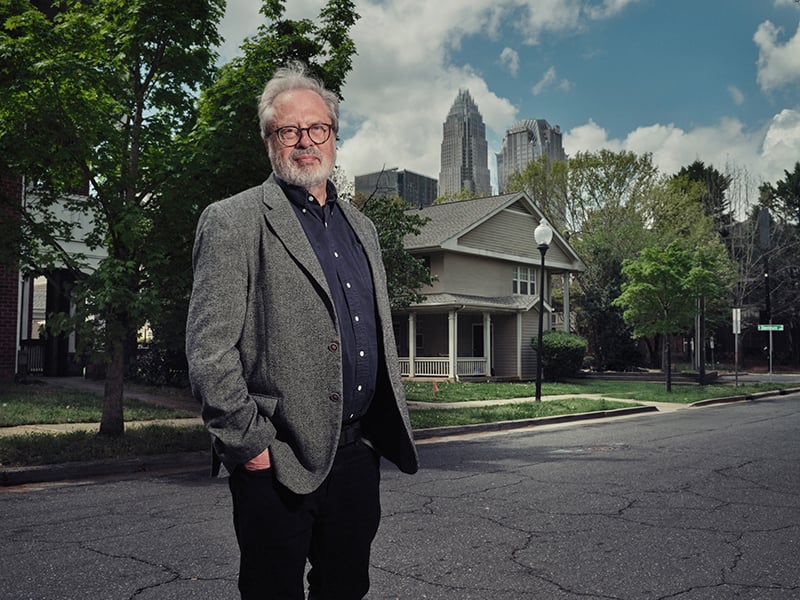The Cost Of Living In Charlotte
Charlotte has struggled to develop affordable housing for more than a century. Despite a slew of efforts to ease the problem, it persists, even worsens, in the face of soaring land and home prices. A new book by Charlotte historian Tom Hanchett chronicles the tenure and depth of the issue and what might—might—be done to make it better.

Walking through First Ward in uptown on a warm late-winter afternoon, Tom Hanchett sees layers of the city invisible to most people.
You might describe the homes we’re walking past as “apartments” and leave it at that. But Hanchett points out that the low-slung, tan buildings with columns and awnings are remnants of the original Earle Village, a public housing complex where more than 400 families lived until the 1990s, when most of it was torn down.
A block away are the Varick on 7th apartments. That’s a mixed-income development recently built by Laurel Street Residential, an offshoot of Charlotte mega-developer Crosland, supported by tax breaks and partially reserved for low-income tenants. It’s named for the founder of the African Methodist Episcopal Zion church, James Varick.
Three blocks away, at Seventh and North Brevard streets, is the Treloar House, an abandoned, red-brick manse where boarded-up windows overlook a cracked asphalt parking lot. Listen to Hanchett talk about it, and you can envision the boarding houses, duplexes, shotgun houses, and corner store that filled the block a century ago. Then, it was home to laborers and professionals, Black and white, living in mixed but not fully integrated proximity.
“If you go back far enough, this was a mixed-income neighborhood—because all neighborhoods were if you go back before the 20th century,” Hanchett says. “There are layers of history.”
That level of granularity—achieved through painstaking research in archival records—old maps, Charlotte News and Charlotte Observer clippings, and first-hand interviews—informs Hanchett’s new book, Affordable Housing in Charlotte: What One City’s History Tells Us about America’s Pressing Problem. He began by compiling the first comprehensive list of 180 affordable housing developments in Charlotte over the past 80 or so years and tracing how they got built. Published in May by UNC Press, the book is a history of the people, programs, and societal trends that have shaped the city’s growth over the past century. It’s also a chronicle of how successive generations have wrestled with an issue that persists to this day: how to house the city’s lowest-income residents.
Hanchett, 69, is a fixture in the (admittedly small) world of Charlotte historians. With his salt-and-pepper beard, Toyota Prius, tweed blazers, and the “Community Historian” name tag he frequently wears, Hanchett looks the part of an academic. You might also run into him around town playing bluegrass fiddle in a band or leading walking tours of the kaleidoscope of immigrant-run restaurants that line the Central Avenue corridor. The former staff historian at the Levine Museum of the New South has also written Sorting Out the New South City: Race, Class & Urban Development in Charlotte, originally published in 1998.
Now, sitting on a bench in the wide, grassy median park on Ninth Street, it doesn’t feel like we’re amid some of the most intensively designed and contentious mixed-income housing in the city, the former site of so-called “projects” and still home to hundreds of subsidized units.
And that’s the point.
“In my generation and previous generations … we were taught to fear low-income housing—and fear is not too strong a word,” Hanchett says. “And the feeling was that if low-income people moved in next door, your life would be ruined—and your property values, even more importantly.
“What this (development) proves is that you can create a neighborhood that has a lot of low-income units but even more middle- and upper-income units, and people will live together.”

Looking southeast from The Market at 7th Street in 2000 (above) and this year. First Ward Place, Varick on 7th, and Autumn Place are apartment complexes with units for low-income residents.
Despite all the recent attention on affordable housing in Charlotte, driven by the astonishing run-up in real estate prices and rent over the past decade, the issue is far from new. As Hanchett illustrates, past generations dealt with their own iterations of the crisis. Some solutions were so plainly beneficial that it’s hard to believe Charlotteans opposed them, like mandating indoor plumbing instead of shared outhouses in all residences, even for poor folks. (More on that later.)
Other solutions praised by generations past are now viewed as disastrous, like the “slum clearance” and “urban renewal” programs that wiped out Brooklyn and other low-income, Black neighborhoods and dispersed their residents. “People were scattered,” Hanchett says. “That anger is still there, particularly in older, low-income African American communities. Just that sense of betrayal. Multiple betrayals.”
Unlike Evicted or Color of Law—bestselling books that have shaped public discourse on low-income housing in recent years—Affordable Housing in Charlotte is mostly free of villains in the form of greedy landlords and racist regulators. Hanchett doesn’t adopt the often-moralizing tone of classic urban development studies like Jane Jacobs’ The Death and Life of Great American Cities and Robert Caro’s The Power Broker. The latter is about Robert Moses, the urban planner whose top-down, bulldozer-forward philosophy of urban development influenced a generation of American architects, engineers, and urban planners.
Hanchett’s book is more like a scene in a heist movie where the crafty thief sprays dust to reveal a hidden lattice of laser beams that surrounds the diamonds. Hanchett methodically dissects the zoning rules, federal tax credits, redevelopment programs, and grants and shows their practical effects: Why low-income housing was built here and not there or, for example, how the Charlotte Housing Authority shifted from building hundreds of apartments in barracks-like buildings to small, 50-unit developments scattered throughout the city.
Hanchett fully acknowledges the murky complexity around affordable housing policy. Big, publicly owned housing developments isolate people on islands of poverty. Breaking up large projects into smaller developments scattered throughout middle-class neighborhoods draws angry neighbors like flowers draw bees. Subsidizing private developers’ efforts to build apartments for a mix of income levels takes forever and falls short of meeting the needs. There’s no single, clear, right answer. Everything is a trade-off.
Ultimately, Hanchett shows how the real bulldozers that flatten some neighborhoods and rebuild others are obscure federal and state programs with an alphabet soup of names: FHA 608, NCHFA, HOPE VI, LIHTC. This hidden grid of rules, lines, and money is the skeleton for the Charlotte we live in today.
And yes, that’s a lot of acronyms. “Hang in with me here,” Hanchett writes at one point. He understands how a book that describes code enforcement and urban renewal in terms of their relative sexiness might lose some casual readers. But one of the surprises in a book about the history of affordable housing in Charlotte is that there’s so much of it to write about. There’s a common perception that nobody’s ever seriously tried to fix affordable housing here. Hanchett shows that in every decade, developers, mayors, community activists, and federal officials have tried all sorts of different policies. Their goals are always to incentivize, build, or subsidize their way out of a simple math problem: Some people don’t make enough money to afford a decent place to live.
Affordable Housing in Charlotte has a Sisyphean quality at times. Earle Village is built by one generation and torn down by the next, and the hazy vision of a city with an affordable, decent place for every person to live seems to recede further into the distance.
But before we get too philosophical, let’s talk about those indoor toilets.
You might take for granted that your house or apartment comes with a toilet. Possibly more than one, all blessedly indoors.
That wasn’t always the case—and much more recently than you might think. Poor residents frequently lacked indoor plumbing as late as the 1940s. Shared outhouses were common, not just in rural settings but in and around the city center.
A few points of this forgotten story apply to affordable housing more broadly today. First, we have a habit of assuming that something is too expensive, even fantastical, before we try it and discover that the cost is fairly trivial. Hanchett compares the uniform adoption of indoor plumbing and affordable housing inclusion mandates for new construction (which aren’t allowed under North Carolina law).
Second, we don’t typically take serious action to confront a problem until it directly affects middle- and upper-class residents. In this case, change happened only when polio washed out of open-pit toilets and into neighborhoods beyond the slums. Charlotte’s lack of universal plumbing was a well-known problem, and not just for the obvious reasons like smell and lack of sanitary conditions. (You might not have considered that outhouse contents tended to freeze in winter.) But the city trundled along, doing its business and doing business, until World War I brought Camp Greene to the outskirts of the city, along what is now Wilkinson Boulevard. When Army inspectors showed up, they were disturbed by the lack of indoor plumbing throughout Charlotte.
According to a 1917 sanitation study, Charlotte had 2,600 outhouses, or “surface closets.” Most served several households. In response, Charlotte did what Charlotte loves to do: set up some committees to study the issue. In this case, Charlotte’s Business and Professional Women’s Club took the lead, with a $500 appropriation to survey the slums.
The solution seemed plain enough: require indoor plumbing. But the building and real estate industry fought the idea for the next three decades. While a 1930 law mandated a “commode and a sink” for all residences connected to a sewer system, it contained no enforcement mechanism and was readily flouted. A 1938 study found that there were still 5,044 dwellings that “have no indoor flush toilets.” The population of Charlotte was less than 130,000 at the time.
Developers argued that connecting houses to plumbing would cost “several thousand dollars.” The added cost to install them in old houses would be unaffordable. Besides, was anyone even sure that lower-income residents really wanted indoor plumbing anyway? “They don’t want bathtubs and they couldn’t pay for them,” one developer grouses. If they were forced to bring all houses up to code, owners warned that they would instead tear down substandard homes and throw 1,000 families out.
The calculus didn’t change until a 1948 polio outbreak. The virus spreads readily through human waste that contaminates water, so no one could deny that the cost of not having mandatory indoor plumbing outweighed the cost of installing it. Within a few years, indoor toilets were standard in all houses—not just those of the more well-off—and it now seems absurd to think that we ever thought they shouldn’t be.
Charlotte, and the U.S. more broadly, have tried different ways to create affordable housing. The earliest way was the simplest—just let people build whatever they want and count on developers to throw up cheap boarding homes or other low-rent accommodations. That’s how we got the block of mixed-income housing that used to surround the Treloar House uptown.
Faced with a big housing shortage after World War II, the federal government started to aggressively subsidize new construction through Federal Housing Administration funding for developers to build modestly priced apartments. Many, like Selwyn Village, were in middle-class areas and had no stigma attached to them. (Future business titans Hugh McColl, Ed Crutchfield, and C.D. Spangler lived and played weekly football games there as young men.) Some of those developments became public housing.
A generation later, in the 1970s, white and Black neighbors tried without success to block Charlotte Housing Authority plans to build five new low-income apartment buildings with almost 1,500 units on and around West Boulevard. The fallout helped kick off the boom in “scattered site” housing that spread throughout the city, with low-income developments of 50 apartments or fewer tucked into multiple neighborhoods.
In his book, Hanchett traces the evolution of federal housing programs from their aggressive expansion in the 1940s to their current reliance on low-income housing tax credits for developers (LIHTC, pronounced LIE-tech) and Section 8 housing vouchers for renters. Along the way, the government spent plenty of time trying to undo past mistakes, like tearing down much of the publicly owned Earle Village and Boulevard Homes projects to replace them with the mixed-income First Ward and Renaissance West developments.
Hanchett illustrates how different programs—like accelerated depreciation tax breaks for real estate development—evolved into new subsidies for developers and vouchers for tenants. Eventually, new programs spawned to pay developers and local governments to tear down and replace the earlier projects.
No affordable housing solution is free of trade-offs. The hands-off, laissez-faire approach created plenty of cheap housing, but much of it was barely habitable (remember the toilets?). Large, publicly owned housing complexes created islands of poverty that kept many families trapped in a generational doom loop.
But tearing these developments down and replacing them with newer, better units disrupted the only support and social networks many of these families knew. Scattered-site housing broke up the pockets of poverty, but each proposal drew “Not in My Back Yard” opposition from neighbors wary of low-income residents and worried that the value of their own property would fall. That created yearslong slogs for every 50-unit building, provided they got built at all.

Hanchett at Renaissance West, a mixed-income community built on the former site of Boulevard Homes (below), a public housing complex torn down in 2011.
The current approach—tax credits for developers to build mixed-income housing—is extremely complex. There aren’t enough credits to go around, especially as inflation drives up construction costs and land prices. Every deal takes years to pull together and requires its own bespoke mix of tax credits, subsidies from other sources like Charlotte’s Housing Trust Fund, and commercial financing.
And new subsidized housing developments typically offer little for the poorest of the poor, people making less than 30% of an area’s median income (in Charlotte, about $23,000 for a family of four). Most subsidized housing is priced for people making at least double or triple that: Think firefighters, teachers, and nurses. (Developers, incidentally, tend to cite those professions to allay neighbors’ fears about the kinds of people who’ll occupy their new housing.)
Still, Hanchett points out that after a century of trial and error, we know enough to say what doesn’t work. Big projects concentrating hundreds of low-income families in a small area? Bad idea. Smaller, scattered developments? Better, especially if they’re near amenities and jobs, but hardly ideal. The best model? A mix of people with a mix of incomes, jobs, and races, living nearby—in other words, places where you can’t tell subsidized from market-rate apartments, and where you don’t even think to ask. Neighborhoods like the ones Hanchett and I are standing in, here in First Ward, where dog walkers in yoga pants parade by a tax credit-subsidized apartment building and don’t give it a second glance.
The decade ahead, though, might be particularly rough for affordable housing. Under federal guidelines, someone making $49,000 a year—the annual salary of a first-year Charlotte-Mecklenburg Schools teacher—can afford to pay roughly $1,200 a month without being “rent-burdened.” The current average rent for a studio apartment in Charlotte? Upwards of $1,400.
One of Hanchett’s goals for the book is to highlight a more typical city than those that have garnered the most attention from historians. More American cities look like Charlotte than New York or Chicago, after all. Another is to blow up readers’ possible misconceptions, like the assumption that all affordable housing projects have ended up as slums; that government action is always ineffective; or that affordable housing is a “them” rather than an “us” issue.
As Hanchett points out, more of us have benefitted from some kind of “affordable housing” than we might like to admit. My now-wife and I rented for almost a decade in Dilworth, living in one unit of a fourplex built in 1952. Back then, developers hastened to build for the postwar baby boom, and the federal government rushed to subsidize them.
Without the cheap rent that we paid for years to live in a desirable neighborhood near uptown, I doubt we would have saved enough to buy the south Charlotte house we live in now. We owe a lot to the “naturally occurring affordable housing” built decades before either of us was born. “There are these assumptions that we have, and maybe the most important of them is that there’s a silver bullet,” says Hanchett, referring to the belief that creating this new voucher program or increasing that subsidy will finally “solve” the issue.
The most dispiriting parts of Hanchett’s book are the success stories that come with asterisks. Earle Village—the poster child for a cheaply built, barracks-like project that concentrated poverty in a tight area—was successfully rebuilt into the attractive, mixed-income development where the author and I are currently chatting. But the finished development contains only about half as many low-income units as the original Earle Village. As higher-income residents moved into the neighborhood, some 200 lower-income families moved out.
Along the same lines, in 2018, Charlotte voters agreed to raise the amount of Housing Trust Fund bonds for low-income housing from $15 million to $50 million every two years. Those bonds are now up to $100 million, more than a sixfold increase over the past decade. But in that time, Charlotte fell further behind in housing units for low-income residents as redevelopment swept through and converted previously low-income neighborhoods like Seversville, Biddleville, and Villa Heights into high-income enclaves.
“At today’s pace, it would take more than 70 years to house people currently in need—not even considering those losing out as naturally occurring affordable housing continues to vanish,” Hanchett writes.
Ultimately, the lack of affordable housing is more of a chronic condition to be managed than an acute crisis to be solved. It’s high blood pressure, not a heart attack. There will always be people who—through poor life choices or no fault of their own, or because of racism or some cruel twist of fate—can’t afford to pay the market price for a place to live. In some decades, there will be more; in others, fewer.
But there will always be some. Hanchett’s message: We can always do something about it.
Ely Portillo is executive editor at WFAE. A Charlotte journalist for more than 15 years, he previously worked at the UNC Charlotte Urban Institute and The Charlotte Observer.








